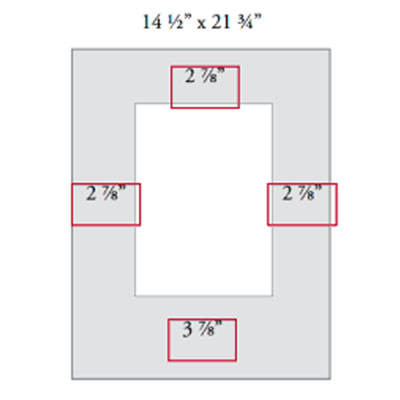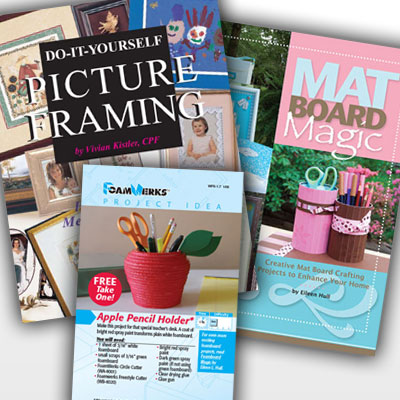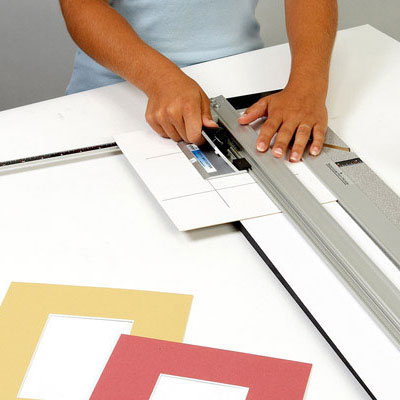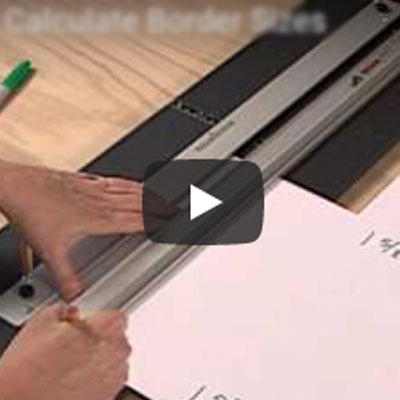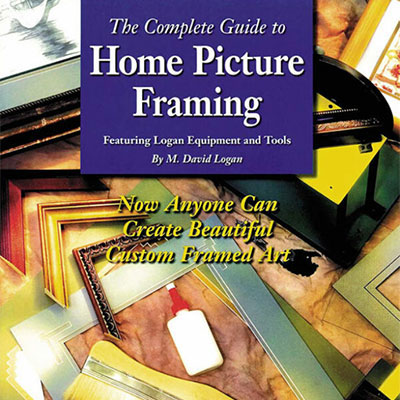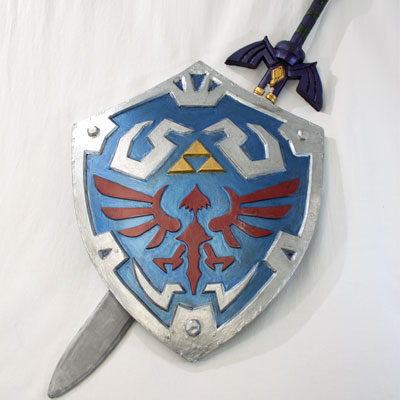The Logan Oval and Circle Mat Cutter operates independently of any other mat cutter and cuts ovals from 3"x 4-1/2" up to 20" x 23" and circles from 4" to 20". The following step by step procedures can be treated as a supplement to the instructions with tips and insights to help you get over common hurtles and get satisfactory results sooner.
Step One: Set the shape of the oval or circle. The design of the Model #201 Oval and Circle Mat Cutter has a bevel cutting head mounted to an arm that rotates around a stationary base. A cam-shaped plate with an adjustable mid-point allows for the setting of different ellipses.
Each shape is determined by adjusting the scale inside the base for the difference between the height and width of the window you want to cut. For example, if you want to cut an 11"x14" oval, you set the differential scale to 3" because 3 is the difference between 11 and 14. If you want a shorter, squatter oval, an 11"x13" is called for and the differential scale is set at 2. By changing the difference between the height and the width, you change the shape of the oval.
Step Two: On the rotating arm, you will find a separate scale. The cutting head is slid along this arm and locked down at the point on the scale indicative of the narrow dimension of your oval. For example, if you want to cut an 11"x14", you set the scale on the arm to 11".
Step Three: Position the oval on the mat. On the face of the mat mark a large plus sign (larger than the base) where you want the middle of the oval window to be. Note: Unlike other mat cutters, oval and circle mat cutters are designed to cut on the face of the mat.
Step Four: Anchor the base to the mat. First, place a second mat of the same size under the mat you are going to cut. This second mat is the underlayment. Without it you will cut through your mat and into the table top. Next, arrange the base over the plus sign, aligning the white score marks on each side of the base with the arms of the plus sign. Caution: the base must be oriented to the mat the same way the window will be oriented to the mat. For example, in most cases you don't want a horizontal oval window oriented to the vertical axis of the mat.
Step Five: Press down firmly on the base with the heels of your hands. The pins under the base will sink into the mat helping to anchor it. However, the pins will not be adequate to hold the base in place once you begin cutting. During cutting you must always hold down firmly on the base with your one hand.
Step Six: Allow the cutting head to swivel into the starting position. The cutting head is mounted on a pin under the scale arm and is designed to swivel. Without the ability to swivel it would be impossible to cut different shaped ovals. Before engaging the blade, it's necessary to allow the cutting head to swivel into position to start the cut.
Holding down firmly on the cutting head, rotate the scale arm around the base. Do not engage the blade. The cutting head will roll forward on its tracking wheel and swivel to assume the curvature of the oval. Caution: the scale arm must only be rotated around the base in a clockwise direction. Caution: do not allow your fingers to touch or obstruct the swiveling cutting head, doing so will prevent the cutting head from swiveling into position and will result in a frayed cut.
Step Seven: Engage the blade. With your thumb resting lightly on top of the cutting head, lift the stepping lever until it clicks. The blade is now engaged.
Caution: You are now at the most critical stage in the process. Anything you do to block or obstruct the swiveling cutting head will result in a frayed cut. Do not let your fingers touch the swiveling cutting head as you rotate the scale arm. However, to achieve the best results rest your thumb lightly on top of the cutting head as you rotate the scale arm.
Step Eight: Rotate the scale arm around the base making a light initial score in the surface of the mat. The cutter is not designed to cut through at this point. Do not exert downward pressure with your thumb on top of the cutting head; rather, let it rest lightly there as you rotate the arm. Keep your fingers well out of the way of the swiveling cutting head. Rotate the arm past the point where the score joins itself before going on to the next step.
Step Nine: With your thumb resting lightly on top of the cutting head, reach down with your index finger and lift the stepping lever to the next step. Rotate the scale arm around the base again. You will feel an increase in resistance as the blade cuts more deeply into the mat.
Step Ten: Lift the stepping lever to the final step. Rotate the scale arm around the base two or three more times. You cannot cut too many times; you can only fail to cut enough times to penetrate the mat. During the final rotations you should exert moderate downward pressure with your thumb on top of the cutting head to insure cutting through.
Step Eleven: Disengage the blade and lift away the drop out piece. Your oval window is complete.
The procedure is exactly the same for cutting circles. The only difference is in how you set up the cutter.






